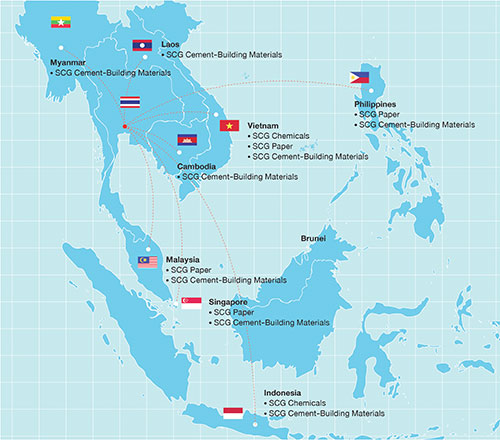SCG sets a clear target to become an ASEAN leader

SCG is undertaking a bold ASEAN wide expansion strategy
SCG’s president and CEO, Kan Trakulhoon has declared “the group’s vision is to become a sustainable ASEAN business leader by the next two years.”
SCG has more than 200 companies and 47,000 employees across ASEAN. Its network in the region has grown continuously with the combined assets totalling $1.8 billion, and is present in Thailand, Vietnam, Indonesia, the Philippines, Laos, Cambodia, Singapore, Malaysia and Myanmar. The cornerstones of the group’s success in the region have been three areas of expertise including cement-building materials, chemicals and paper.
SCG Cement-Building Materials, in addition to conducting business in Thailand, is also investing in the region’s cement-building materials industry.
SCG Cement-Building Materials makes assorted premium quality building materials products, including grey and white cement, ready-mix concrete, mortar and refractory products, concrete paving blocks, roof and ceramic tiles, fibre-cement board and wood substitutes, sanitary ware and fittings, and insulation, as well as modular housing.
Apart from Thailand, the group has established a cement plant in Cambodia and is building another in Indonesia where it has already acquired a market leader in ready-mixed concrete. The business is building a unique strong network of distribution channels in the ASEAN region, while continuing to export its products throughout the region. In Vietnam, SCG acquired an 85 per cent stake in Prime Group, Vietnam’s leading building materials manufacturer. This latest investment has propelled SCG to become the world’s largest ceramic tile producer with a production capacity of 225 million ceramic square metres, combined with productions in ASEAN countries. The group also established CPAC Monier (Vietnam) Co., Ltd. in 2006 to provide concrete roof tiles to the Vietnamese market.
Meanwhile, SCG Paper, which has become the leading paper producer in ASEAN, is the only company in the ASEAN region to operate an integrated paper industry, covering the production of everything from pulp to printing and writing paper. SCG Paper has factories in Thailand and further afield in Vietnam, the Philippines, Singapore and Malaysia.
In Vietnam, the business has expanded its position by the establishment of Vina Kraft Paper Co., Ltd. in the southern Binh Duong province providing high-quality kraft paper since 2010. The company recently expanded its business to offer diverse products and services including the corrugated containers industry, a growing segment in Vietnam. Its subsidiaries also include New Asia Industries Co., Ltd., AP Packaging (Hanoi) Co., Ltd., Alcamax Packaging (Vietnam) Co., Ltd. and Packamex (Vietnam) Co., Ltd.
Meanwhile, SCG Chemicals has built production bases in Vietnam and Indonesia and is continuing to discover business expansion opportunities in ASEAN. In Vietnam, SCG has also joined hands with Qatari and Vietnamese partners for the development of Vietnam’s first petrochemical complex in the southern province of Ba Ria-Vung Tau, while also operating TPC Vina Chemical and Plastic Corporation Co., Ltd. to provide PVC Resin.
Production and quality controls are based on modern technology and changing consumer lifestyles, making SCG a market leader in building materials in the ASEAN region. Additionally, SCG’s export markets have continuously expanded. Important export markets include ASEAN, Europe, the US and Australia.
Trakulhoon asserted the group’s commitment to the region, “we will continue the expansion of our investment in our three core sectors - cement-building materials, paper and chemicals. To achieve that, we have employed two key strategies – expansion into the region, and development of high value added products, while building a better quality of life and a sustainable society under our sustainable development framework.”
What the stars mean:
★ Poor ★ ★ Promising ★★★ Good ★★★★ Very good ★★★★★ Exceptional
Latest News
More News
- Businesses ramp up production as year-end orders surge (December 30, 2025 | 10:05)
- Vietjet chairwoman awarded Labour Hero title (December 29, 2025 | 13:06)
- How to unlock ESG value through green innovation (December 29, 2025 | 10:03)
- AI reshapes media and advertising industry (December 29, 2025 | 08:33)
- FPT and GELEX sign deal to develop blockchain tech for global markets (December 29, 2025 | 08:29)
- Vietnam’s GDP forecast to grow by 9 per cent in 2026 (December 29, 2025 | 08:29)
- Women entrepreneurs are key to Vietnam’s economic growth (December 29, 2025 | 08:00)
- Vietnam's top 500 value-creating enterprises announced (December 27, 2025 | 08:00)
- The PAN Group shaping a better future with ESG strategy (December 26, 2025 | 09:00)
- Masan Consumer officially lists on HSX, marking the next phase of value creation (December 25, 2025 | 13:20)

















 Mobile Version
Mobile Version